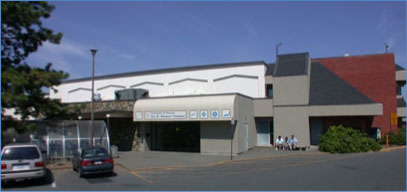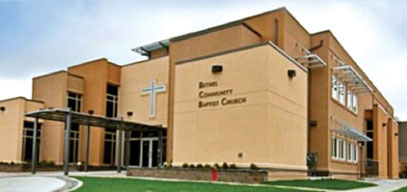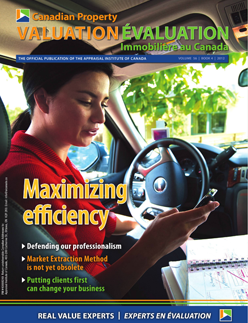Market Extraction Method is not yet obsolete
Évaluation immobilière au Canada
Rechercher dans la bibliothèque en ligne
By John Peebles, AACI
Institutional properties are tough valuation assignments. Sales are scarce, the building design and construction is often unique, and rents are not common, since these properties are almost always owner-occupied. Appraisers are often called to value institutional properties when the current use terminates and the property is vacant or converted to an alternate use. The Cost Approach is generally the prime appraisal method for institutional properties, given the lack of rents and scarcity of comparable sales. Measuring the loss in value from functional and external obsolescence can be the biggest challenge for these assignments.
In this article, I explore the use of the Market Extraction Method to determine an overall obsolescence factor for an institutional property. The Dictionary of Real Estate Appraisal defines institutional property as Property of a public nature owned and operated by the government or a non-profit organization. Common examples are places of worship, public and private schools, university education and research facilities, health-care facilities, conference centres, and museums.
The Appraisal of Real Estate provides several methods or tests to identify and measure forms of obsolescence: income analysis, paired sale analysis, and market extraction methods. Since institutional properties are rarely rented and paired sales are virtually unknown, the Market Extraction Method is an important analysis tool. In this method, the reproduction cost new (RCN) of the property being appraised is compared with similar, or benchmark property sales, adjusted for site value.
Before examining this method in detail, a brief refresher is in order on the two forms of real estate obsolescence: functional and external. Functional obsolescence is about the efficiency of the improvements to continue to perform the use identified as the highest and best use, the most reasonable, probable, profitable use. Building design, building systems and materials are constantly evolving and improving. In some cases, the same level of productivity can be delivered from a smaller, modern building. All of the inefficiencies associated with older, outmoded improvements that measurably impact property value contribute to functional obsolescence. In contrast, economic (also called external) obsolescence is about external, macro-economic forces that impact the value of real estate. Some of these forces are changes in labour costs, local industry competitiveness relative to other regions, over-capacity in the industry, consumer tastes, population shifts, changes in transportation networks, and competition from new products and technologies. A cautionary note; it may be possible to clearly identify property functional versus external obsolescence issues. However, the task of distinguishing the value impact of these two factors will be difficult – there is a risk of double counting depreciation.
The steps in the Market Extraction Method are as follows.
Step 1
Determine the reproduction cost new (RCN) of the subject property.
Step 2
Identify sales of benchmark properties, determine the total physical depreciation of each benchmark sale at the sale date, and estimate the contributory land value of the sale.
Step 3
Deduct the estimated land value from each benchmark sale price to arrive at the residual value contribution of the improvements. This amount represents the total depreciated value of the improvements, including all forms of depreciation.
Step 4
Add the estimated residual improvement value and physical depreciation for each benchmark (at the sale date) and deduct this amount from the benchmark RCN.
The difference between the RCN of each benchmark and the sum of the residual improvement value and physical depreciation at the sale date is the remaining depreciation attributable to all forms of obsolescence.
The obsolescence estimate can be expressed as a percentage of the benchmark RCN.
Step 5
Reconcile the obsolescence percentage outcomes from the Market Extraction analysis to arrive at a supportable obsolescence adjustment for the subject property.
Step 6
Apportion the obsolescence estimate into functional and external components. Refer to the Appraisal of Real Estate for methods of apportioning obsolescence. Apply the percentage adjustments to the RCN of the subject property through the Cost Approach and communicate the limitations of the analysis to the intended user(s).
Market Extraction is a logical and appealing appraisal model to forecast functional and external obsolescence. Yet, the premise that each form of depreciation can always be clearly identified and allocated is unrealistic, especially for institutional properties. In many scenarios the Extraction Method will end at Step 5, meaning functional and economic obsolescence must be treated as a combined value impact.
Our case study is a former retirement residence and retreat for a religious order. The property, located on 15 acres in suburban Victoria, is similar in design to an assisted living facility. Two principal buildings are designed with two levels of accommodation, common dining areas, commercial kitchens, recreation and lounge space, a connecting chapel, and other support facilities. The two principal buildings were constructed in 1966, with an additional facility erected in 1982. The total gross building area of both buildings is about 63,000 ft2. Given the decline in residents at the residence over the years and rising operating costs the church decided to divest the property. There is a post-secondary institution that is interested in acquiring the property and potentially adapting the improvements for education use. Let’s assume you have been engaged by the parties to determine the market value of the property for negotiation purposes.
Following the appraisal process, your work begins with a site and improvement analysis. The property is an attractive treed acreage located in a desirable higher income suburban neighbourhood near the university. The site is irregular in shape, with moderately level terrain and frontage on three public roads. The existing site area coverage of the improvements is low – about 10%. The current improvements require a site area of about 10 acres, meaning ± 5 acres are surplus and may have potential for additional development. However, the zoning restricts the use to a range of personal care uses, including the current use – assisted living. Any attempt to change the zoning would require long-term discussions and buy-in from a very strong and vigilant local community association and local residents.
An improvement analysis reveals that there are a number of functional issues associated with the building design (small accommodation rooms with limited ensuite facilities), inefficient HVAC, and other obsolete features. These issues are incurable – meaning the cost to correct the design problems and modernize the improvements is significantly greater than the corresponding increase in value. However, the building envelope is in good condition and the improvements continue to have remaining economic life for their intended use. The improvements may also be impacted by external obsolescence. According to your research, fewer faith communities are developing care facilities for their members due to the high capital cost, complexity of government licencing, and need for specialized expertise to operate lodging, food, and care services for the residents. The facility does not meet current design and accommodation standards for residential care facilities. It is unlikely that an established assisted living operator could be secured to purchase the property and upgrade the facilities to ensure profitable operations.
The next step is to take into account your investigation of the zoning, site and improvements to determine the property’s highest and best use. You conclude that the current assisted-living use is the only probable and legal use in the short-term. However, there are other long-term options to be considered. Viable institutional uses that permit the property to be maintained as an intact ‘green’ acreage may be supported by residents. Two Institutional uses that residents may support are keeping most of the site intact and conversion of the improvements to private school use or post-secondary student housing and education associated with the nearby university. It may be possible in the long-term to develop the five acres of surplus land with higher end housing consistent with the neighbourhood development. However, there are no plans before local government and the local community for alternative uses. Any use other than the current legally permitted use would be speculative. You conclude that the highest and best use conclusion is a continuation of the current use with some possibility of low-density housing in the long-term. You also conclude that it is probable that a potential purchaser would recognize the property’s functional and economic obsolescence in negotiating the purchase price. The next step is the valuation analysis.
The Cost Approach and Direct Comparison Approach are both appropriate valuation methods for this assignment. Since our goal in this article is measuring obsolescence, we focus on the Cost Approach. Assume that the land value has been estimated at $8.1 million through comparative land sales analysis. The RCN of the improvements has been estimated at ± $16 million, relying on commercial manual costs and advice from contractors. After accounting for the different effective ages of the two principal improvements, the depreciated improvement value is estimated at $11,421,000. The next step is to account for the impact of functional and economic obsolescence with the Market Extraction Method.
This analysis begins with the identification of benchmark institutional property sales in the region. Ideally, these sales should be representative in size and construction relative to our subject property. The reality is very different. Your investigations confirm that sales evidence is limited and the few potential benchmark sales have unique design and use. All of the benchmark institutional property sales are located in the Greater Victoria area. These sales have occurred over an extended time frame – meaning different market conditions. The icing on the cake is that most of the benchmarks are court ordered sales. On the positive side, you have file information on these properties through previous valuation work, listings, broker documents, and other reliable sources. Each benchmark has notable examples of obsolescence. You can revisit your files to update the costs for these benchmarks at the property effective sale dates.
The first case study is the dated sale of a large private sports facility near the University of Victoria. At the date of sale, the facility included tennis courts, gym, outdoor pool, and an ice rink. The property, in receivership, sold to a well-known local private school.

Benchmark 1 – Private recreation complex
| A Determine depreciated value of improvements at sale date | ||
| Construction date | 1966 | % of RCN |
| Sale date | October 1986 | |
| RCN at sale date | $5,422,000 | |
| Physical depn at sale date | $1,832,636 | 33.8% |
| B Identify the residual value to the improvements at sale date | ||
| Sale price | $1,970,000 | |
| Land value | $1,250,000 | |
| Residual to improvements | $720,000 | 13.3% |
| C Determine the remaining depreciation from obsolescence | ||
| Obsolescence estimate | $2,869,364 | 52.9% of RCN |
The purchaser resold the recreation centre to the University of Victoria after improvements to the sports facilities and the addition of new instructional-office space. It was necessary to establish a new replacement cost base.
Benchmark 2 – Resale of recreation complex
| A Determine depreciated value of improvements at sale date | ||
| Construction date | 1966 | |
| Sale date | Summer 2000 | |
| RCN at sale date | $8,045,000 | |
| Physical depn at sale date | $2,532,000 | 31.5% |
| B Identify the residual value to the improvements at sale date | ||
| Sale date | October 1986 | RCN |
| Sale price | $4,325,000 | |
| Less land value | $2,870,000 | |
| Residual to improvements | $1,455,000 | 18.1% |
| C Determine the remaining depreciation from obsolescence | ||
| RCN – phys. depn – residual imp. | $4,058,000 | 50.4% of RCN |
The percentage of the RCN associated with obsolescence continues to be in the order of 50%.
The next benchmark is the sale of a non-operating 1990s-era boutique resort. This 35-room lodging property is located north of Victoria at the summit of Malahat Drive. While not an institutional property, the location and unique design of the resort make it a limited market property worthy of research. The very scenic location, combined with luxury accommodation and three-star food services, initially contributed to successful operations. However, the resort failed financially after the 2008 global economic recession and was eventually closed and placed in receivership.

Benchmark 3 – Sale of a boutique resort (not operating)
| A Determine depreciated value of improvements at sale date | ||
| Construction date | 1990 | |
| Sale date | September 2011 | |
| RCN at sale date | $6,884,000 | |
| Physical depn at sale date | $2,065,200 | 30.0% |
| B Identify the residual value to the improvements at sale date | ||
| Sale price | $3,100,000 | |
| Less land value | $3,575,000 | |
| Residual to improvements | -$475,000 |
Since this property sold through court order for an amount less than the land value, we stop at step B. In this extreme example, our Market Extraction Model provides little guidance, since the market has attributed no remaining value to the improvements.
Benchmark 4 is a more contemporary example of an institutional facility with some similarity to the subject property. This benchmark is a combined church, conference centre, and assisted living facility located in Sidney, BC. The property represents a unique project funded partially by the faith community, local investors, and secondary lenders. While the concept initially appeared viable, this 82,000 ft2 project was underfunded and the church failed to acquire the necessary residents for the care component of the property. The property was sold through a court order for a significant discount.
Benchmark 4 – church and care home sale

| Step 1 Determine depreciated value of improvements at sale date | ||
| Construction date | 2009 | |
| Sale date | Oct 2012 | |
| RCN at sale date | $22,000,000 | |
| Physical depn at sale date | $1,100,000 | 5.0% |
| Step 2 Identify the residual value to the improvements at sale date | ||
| Sale price | $11,500,000 | |
| Less land value | $2,613,600 | |
| Residual to improvements | $8,886,400 | 40.4% |
| Step 3 Determine the remaining depreciation from obsolescence | ||
| RCN – phys. depn – residual imp. | $12,013,600 | 54.6% of RCN |
The range in obsolescence estimates is roughly 50% to 55% of RCN, excluding Benchmark 3, the boutique resort. Since the market data to support allocation of obsolescence between functional and economic factors is not available, our next step is to reconcile our benchmark indicators. The combined church – retirement residence is the most recent benchmark and is most similar in construction and design relative to the subject. The church and the subject property are both unoccupied. Giving most weight to the church – retirement residence benchmark, the overall obsolescence factor is 55%. We now have a factor to apply in the Cost Approach after accounting for physical depreciation. A simplified Cost Approach is presented in the following table:
Note that the 55% obsolescence factor is applied to the estimated RCN of the subject property.
Summary
What can we conclude about the strengths and limitations of our Market Extraction case studies? First, this method provides more direct market evidence of obsolescence and is more convincing than an arbitrary guestimate based on one’s general experience. However, there are limitations to the obsolescence analysis that should be disclosed to any intended user of an appraisal or consulting report. First, this analysis is notional in nature, since it involved several transformations of market information – a process that buyers and sellers may not rely on when arriving at a negotiated sale price. The second issue is the unique nature of each benchmark property and conditions of sale. For example, Benchmark 3 is an example of the industry specific nature of obsolescence. The market dynamics of the resort accommodation industry are very different than the not-for-profit assisted living sector and other types of institutional properties. The rural location of the boutique resort, poor outlook for resort properties, and high risk in acquiring a closed lodging operation were factors that contributed to the low sale price. Our last point is to be careful with court ordered sales. While the court may direct that the property be marketed in an orderly and open sale process to ensure multiple offers, there is often a stigma or intangible value impact associated with these offerings. While Benchmark 4 was a court ordered sale, the buyers still paid a substantial amount for the property – well in excess of the underlying land value.
Those who would like to further explore techniques for estimating functional and economic depreciation can refer to the short reading list at the end of this article.
End notes
Appraisal Institute of Canada, The Appraisal of Real Estate: 3rd Canadian Edition, 2010, p.19.34.
2 Appraisal Institute, The Dictionary of Real Estate Appraisal: 4th Edition, 2002, p. 147.
3 A Model is our attempt to represent reality, in this case the behavior of participants in real estate markets, to forecast outcomes. A depreciation model is our attempt at predicting the reduction in value that a purchaser would assign to property improvements associated with various forms of depreciation.
4 We will revisit these limitations at the end of our analysis.
References
Michael Remsha, Identifying and Quantifying Economic Obsolescence, American Appraisal, 2001 Property Tax Symposium, La Jolla, 2001. http://www.american-appraisal.com/US/Library/Articles/Identifying-and-Quantifying-Ec.htm
Robert Reilly, Functional Obsolescence and Economic Obsolescence Considerations in Property Tax Valuation, Ad Valorem Property Tax Insights, Summer 2012. http://www.willamette.com/insights_journal/12/summer_2012_13.pdf
Nelson Bowes, In defense of the Cost Approach: A Journey into Commercial Depreciation, Appraisal Institute, Chicago, 2011.
Rudy Robinson and Scott Lucas, Appraising special-purpose industrial facilities for Ad Valorem purposes, Appraisal Journal, Appraisal Institute, October 2003, vol. 71/4.
Max Derbes, Accrued Depreciation: Classical Method, The Real Estate Appraiser, Society of Real Estate Appraisers, August 1965, vol. 31/08.
-30-





